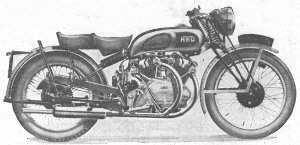Prior to WWII, Phil Vincent bought the rights to the Howard R. Davies company, (founded in 1924?), and adopted the name Vincent-HRD for his entry into the British motorcycle market. Other than the name, there was little similarity between the HRD and the new model, a J.A.P. powered single released in 1929.
The new Rapide was announced to the world in 1937. One statement in the press read: 'The idea behind the design, is the production of an exceptionally lively, high-performance mount with the same superb handling as the smaller models in the range. Not only this, but the makers have aimed at providing a 100 mph machine that is docile and does not rely on supertuning for its out-of-the-ordinary capabilities or require an ultra-high compression ratio.'
The Series A Rapide had many innovations, not least of which was the cantilever rear springing system already proven on the single-cylinder Vincent HRDs. Decades later Yamaha introduced their monoshock system - for all intents and purposes a straight copy of the Vincent system. The Rapide's other features included a stainless steel tank, twin brakes on both wheels, and a duplex primary chain connecting the powerful V twin engine to the Burman four speed gearbox.
These machines proved fast and reliable, and sold reasonably well up until the onset of war in 1939. The Series B Rapide was announced in 1945, very shortly after the war's end. The new machine had many refinements and changes including a 50° cylinder angle and internal oil galleries. This basic layout was retained for the C and D models, the last of which was built in 1955.
A factory-prepared, unfaired Black Lightning achieved 150mph at Bonneville Salt Flats in 1948, ridden by Rollie Free who had stripped to a swimsuit in search of extra speed.
In 1948 the Indian factory sent a Chief to the Vincent factory to have a Rapide engine fitted. Examples were successfully tested on both sides of the Atlantic but the machine did not go into production. A photograph of a very fine Australian restoration is available at IndianChiefMotorcycles.com.
In 1998 an Australian company, RTV, was formed to build replica Vincent motors which were inserted in a modern high-performance chassis. Very few motors were built, and the company folded the following year.
VINCENT HRD - Series A Rapide |
|
 |
|
Specifications |
|
| Make: | Vincent HRD |
| Model: | Series A Rapide |
| Engine: | 998 cc (84 x 90 mm bore and stroke) 47° OHV V Twin |
| Tyres: | 3 x 20 in front, 3 x 19 in rear |
| Frame: | Brazed lug duplex tubular cradle. Cantilever rear springing |
| Front forks: | Girder forks |
| Brakes: | Twin drums, 7 in diameter in front and rear |
| Weight: | 400 lb |
| Wheelbase: | 58.5 in |
| Manufacturer: | The Vincent-HRD Co. Ltd., Great North Road, Stevenage, Herts |
| VINCENT HRD - Series C Black Shadow | |
Specifications |
|
| Make: | Vincent HRD |
| Model: | Series C Black Shadow |
| Engine: | 998 cc (84 x 90 mm bore and stroke) 50° OHV V Twin, 7.3:1 CR, polished conrods |
| Carburetor: | 2 x 1.125 inch type 29 Amals |
| Ignition: | Lucas Magneto ('55 models had Kettering ignition) |
| Electrics: | 6v 45w dynamo |
| Lubrication: | Dry sump, 3 US quarts |
| Gearbox: | Burman 4 speed, triplex chain primary, wet multiplate clutch |
| Final Drive: | 530 chain, 46/21 sprockets |
| Tyres: | 3 x 20 in front, 3.50 x 19 in rear |
| Wheels | Front: 1.65 x 20 in.steel rim; Rear: 1.65 x 19 in.steel rim. |
| Frame: | Brazed lug duplex tubular cradle. Cantilever rear springing |
| Front forks: | Vincent Girdraulic forks, 3" travel |
| Brakes: | Twin drums, 7 in diameter in front and rear, single leading shoe 7/8" wide. |
| Weight: | 455 lb - 206 kg [Wet - 500 lb (227kg)] |
| Wheelbase: | 56.5 in. (1435mm) |
| Seat height: | 32.5 in. (826mm) |
| Performance: | 125 mph / 201 km/h - 55 bhp at 5500 rpm |
| Fuel Capacity | 3.5 gallons / 16 litres (Other sources suggest 5 gal - 19litres) |
| Manufacturer: | The Vincent-HRD Co. Ltd., Great North Road, Stevenage, Herts |
The Black Lightning had different cams, higher strength connecting rods, larger inlet ports, polished rocker gear, steel idler gears, racing carburetors, a manual-advance magneto and was available with compression ratios between 6.8:1 and 12.5:1.
Site by ManxNorton.com 